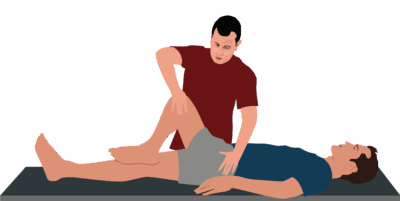Patrick’s (FABER) Test
The Patrick’s Test (also known as the FABER Test or the Figure-Four Test) is an orthopedic maneuver used to identify hip joint, sacroiliac (SI) joint, or surrounding soft tissue pathology in clients with lower back, hip, buttock, or groin pain. It provokes or reproduces pain by mechanically stressing the hip and SI joint structures.
How the Test is Performed
-
Client position: Supine on the table.
-
The examiner moves the tested leg into flexion, abduction, and external rotation so the ankle rests just above the contralateral knee (“figure-4” position).
-
The pelvis is stabilized at the opposite anterior superior iliac spine (ASIS) with one hand, and gentle downward pressure is applied to the tested knee with the other, increasing hip and SI joint stress.
-
A positive sign: Reproduction of pain:
-
Groin pain suggests intra-articular hip pathology (labral tear, arthritis, hip impingement)
-
Posterior hip/SI pain suggests SI joint dysfunction
-
Lateral or unspecified pain may indicate hip capsule, soft tissue, or referred lumbar involvement.
-
Clinical Significance
-
Localizes pain and guides identification of hip joint versus SI joint versus referred lumbar pathology.
-
Positive findings must be interpreted alongside history, ROM, strength, and palpation. Note that FABER identifies pain, not a specific diagnosis.
-
Especially useful in clients with ambiguous lower back, hip, or pelvic pain.
Assessment
-
Use the FABER Test during assessment for clients with lower back, pelvic, hip, buttock, or groin pain.
-
Clearly document which movement or position provokes pain and its location (groin, buttock, back, lateral thigh, etc.) for treatment planning and interprofessional communication.
-
Use as part of a cluster with other orthopedic tests for a comprehensive evaluation.
Treatment
-
If hip joint pain: Avoid aggressive joint mobilizations or deep techniques over the anterior hip; focus on gentle stretching, soft tissue release, and pain relief until pathology is clarified or cleared medically.
-
If SI pain: Use caution with direct sacroiliac mobilization or forceful techniques; support with gentle myofascial and global pelvic therapy.
-
For soft tissue limitations: Myofascial release and flexibility work for hip flexors, adductors, and external rotators may help restore symptom-free motion.
Safety and Referral
-
Refer for further imaging/assessment if significant restriction, persistent/progressive pain, or symptoms of intra-articular hip/SI joint pathology are present.
-
Always coordinate with physiotherapists or physicians for confirmed intra-articular or SI joint conditions.

